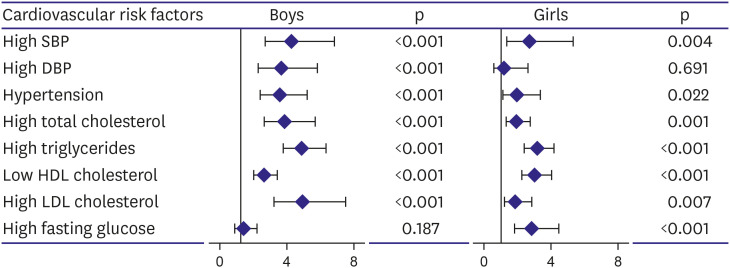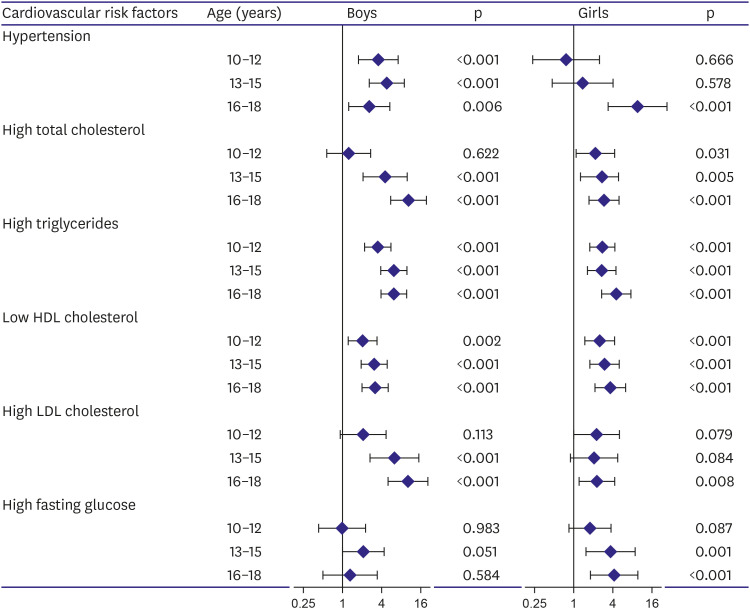Korean Circ J.
2020 Aug;50(8):723-732. 10.4070/kcj.2019.0329.
Relationship between Waist Circumference and Cardiovascular Risk Factors in Adolescents: Analysis of the Korea National Health and Nutrition Examination Survey Data
- Affiliations
-
- 1Department of Pediatrics, Korea University Medical Center, Korea University College of Medicine, Seoul, Korea
- 2Division of Pediatric Cardiology, Department of Pediatrics, Seoul National University Bundang Hospital, Seongnam, Korea
- KMID: 2505127
- DOI: http://doi.org/10.4070/kcj.2019.0329
Abstract
- Background and Objectives
High waist circumference (WC) is associated with increased cardiovascular risk (CVR) in adulthood. We investigated this association in adolescents.
Methods
We performed a cross-sectional analysis of data for 10–18-year-olds included in the Korea National Health and Nutrition Examination Survey (KNHANES) (2005–2014). The association between WC and CVR factors was evaluated. We analyzed this relationship according to age.
Results
We analyzed 8,153 participants (4,319 boys and 3,834 girls) from the KNHANES. High WC was associated with increased incidence of CVR factors: hypertension (odds ratio [OR], 3.5 in boys, 1.9 in girls), high total cholesterol (OR, 3.9 in boys, 1.9 in girls), high triglycerides (OR, 4.9 in boys, 3.2 in girls), high low-density lipoprotein (LDL) cholesterol (OR, 5.0 in boys, 1.8 in girls), low high-density lipoprotein (HDL) cholesterol (OR, 2.6 in boys, 3.0 in girls), and hyperglycemia (OR, 2.8 in girls). In boys, the association between high WC and hypertension, high triglycerides, and low HDL cholesterol was noted in early adolescence. High WC was associated with high total cholesterol and high LDL cholesterol in middle adolescence. In girls, high WC was correlated with high total cholesterol, high triglycerides, and low HDL cholesterol in early adolescence. High WC was shown to be associated with hyperglycemia in middle adolescence, and with hypertension and high LDL cholesterol in late adolescence.
Conclusions
High WC in adolescents is associated with increased CVR. The timing of this association differs according to sex and CVR factors.
Figure
Cited by 1 articles
-
Cardiovascular Risk Factors and Obesity in Adolescents
Sung Hye Kim
Korean Circ J. 2020;50(8):733-735. doi: 10.4070/kcj.2020.0247.
Reference
-
1. Seidell JC, Halberstadt J. The global burden of obesity and the challenges of prevention. Ann Nutr Metab. 2015; 66(Suppl 2):7–12.
Article2. Lim SS, Vos T, Flaxman AD, et al. A comparative risk assessment of burden of disease and injury attributable to 67 risk factors and risk factor clusters in 21 regions, 1990–2010: a systematic analysis for the Global Burden of Disease Study 2010. Lancet. 2012; 380:2224–2260. PMID: 23245609.3. Ng M, Fleming T, Robinson M, et al. Global, regional, and national prevalence of overweight and obesity in children and adults during 1980–2013: a systematic analysis for the Global Burden of Disease Study 2013. Lancet. 2014; 384:766–781. PMID: 24880830.4. Van Gaal LF, Mertens IL, De Block CE. Mechanisms linking obesity with cardiovascular disease. Nature. 2006; 444:875–880. PMID: 17167476.
Article5. Skinner AC, Perrin EM, Moss LA, Skelton JA. Cardiometabolic risks and severity of obesity in children and young adults. N Engl J Med. 2015; 373:1307–1317. PMID: 26422721.
Article6. Ajala O, Mold F, Boughton C, Cooke D, Whyte M. Childhood predictors of cardiovascular disease in adulthood. A systematic review and meta-analysis. Obes Rev. 2017; 18:1061–1070. PMID: 28545166.
Article7. Lloyd LJ, Langley-Evans SC, McMullen S. Childhood obesity and adult cardiovascular disease risk: a systematic review. Int J Obes. 2010; 34:18–28.
Article8. World Health Organization. Obesity: preventing and managing the global epidemic. Geneva: World Health Organization;2000.9. Lee CM, Huxley RR, Wildman RP, Woodward M. Indices of abdominal obesity are better discriminators of cardiovascular risk factors than BMI: a meta-analysis. J Clin Epidemiol. 2008; 61:646–653. PMID: 18359190.
Article10. Bassali R, Waller JL, Gower B, Allison J, Davis CL. Utility of waist circumference percentile for risk evaluation in obese children. Int J Pediatr Obes. 2010; 5:97–101. PMID: 19606372.
Article11. Zimmet P, Alberti KG, Kaufman F, et al. The metabolic syndrome in children and adolescents - an IDF consensus report. Pediatr Diabetes. 2007; 8:299–306. PMID: 17850473.
Article12. Leibowitz KL, Moore RH, Stunkard AJ, et al. Cardiovascular disease risk factor (CVDRF) associated waist circumference patterns in obese-prone children. Int J Pediatr Obes. 2009; 4:150–159. PMID: 19101853.
Article13. Kweon S, Kim Y, Jang MJ, et al. Data resource profile: the Korea National Health and Nutrition Examination Survey (KNHANES). Int J Epidemiol. 2014; 43:69–77. PMID: 24585853.
Article14. Moon JS, Lee SY, Nam CM, et al. 2007 Korean National Growth Charts: review of developmental process and an outlook. Korean J Pediatr. 2008; 51:1–25.
Article15. Friedewald WT, Levy RI, Fredrickson DS. Estimation of the concentration of low-density lipoprotein cholesterol in plasma, without use of the preparative ultracentrifuge. Clin Chem. 1972; 18:499–502. PMID: 4337382.
Article16. Flynn JT, Kaelber DC, Baker-Smith CM, et al. Clinical practice guideline for screening and management of high blood pressure in children and adolescents. Pediatrics. 2017; 140:e20171904. PMID: 28827377.17. Lauer R, Barness L, Clark R, et al. National Cholesterol Education Program (NCEP): highlights of the report of the expert panel on blood cholesterol levels in children and adolescents. Pediatrics. 1992; 89:495–501. PMID: 1741227.18. Expert Panel on Integrated Guidelines for Cardiovascular Health and Risk Reduction in Children and Adolescents. National Heart, Lung, and Blood Institute. Expert panel on integrated guidelines for cardiovascular health and risk reduction in children and adolescents: summary report. Pediatrics. 2011; 128(Suppl 5):S213–S256. PMID: 22084329.19. Ashwell M, Gunn P, Gibson S. Waist-to-height ratio is a better screening tool than waist circumference and BMI for adult cardiometabolic risk factors: systematic review and meta-analysis. Obes Rev. 2012; 13:275–286. PMID: 22106927.
Article20. Katzmarzyk PT, Srinivasan SR, Chen W, Malina RM, Bouchard C, Berenson GS. Body mass index, waist circumference, and clustering of cardiovascular disease risk factors in a biracial sample of children and adolescents. Pediatrics. 2004; 114:e198–e205. PMID: 15286257.
Article21. Cook S, Auinger P, Huang TT. Growth curves for cardio-metabolic risk factors in children and adolescents. J Pediatr. 2009; 155:S6.e15. S6.e26.
Article22. Janssen I, Katzmarzyk PT, Srinivasan SR, et al. Utility of childhood BMI in the prediction of adulthood disease: comparison of national and international references. Obes Res. 2005; 13:1106–1115. PMID: 15976154.
Article23. Garnett SP, Baur LA, Srinivasan S, Lee JW, Cowell CT. Body mass index and waist circumference in midchildhood and adverse cardiovascular disease risk clustering in adolescence. Am J Clin Nutr. 2007; 86:549–555. PMID: 17823416.
Article24. Perichart-Perera O, Balas-Nakash M, Schiffman-Selechnik E, Barbato-Dosal A, Vadillo-Ortega F. Obesity increases metabolic syndrome risk factors in school-aged children from an urban school in Mexico city. J Am Diet Assoc. 2007; 107:81–91. PMID: 17197275.
Article25. Savva SC, Tornaritis M, Savva ME, et al. Waist circumference and waist-to-height ratio are better predictors of cardiovascular disease risk factors in children than body mass index. Int J Obes Relat Metab Disord. 2000; 24:1453–1458. PMID: 11126342.
Article26. Bell L, Hung J, Knuiman M, et al. Body mass index and waist circumference: relationship to cardiometabolic risk factors in children--Busselton Health Study 2005–2007. J Paediatr Child Health. 2013; 49:955–962. PMID: 23802746.27. Flodmark CE, Sveger T, Nilsson-Ehle P. Waist measurement correlates to a potentially atherogenic lipoprotein profile in obese 12–14-year-old children. Acta Paediatr. 1994; 83:941–945. PMID: 7819691.
Article28. Freedman DS, Serdula MK, Srinivasan SR, Berenson GS. Relation of circumferences and skinfold thicknesses to lipid and insulin concentrations in children and adolescents: the Bogalusa Heart Study. Am J Clin Nutr. 1999; 69:308–317. PMID: 9989697.
Article
- Full Text Links
- Actions
-
Cited
- CITED
-
- Close
- Share
- Similar articles
-
- Factors associated with Obesity among Korean Adolescents based on the Seventh Korea National Health and Nutrition Examination Survey (2016)
- The Relationship between Waist Circumference and Work-related Injury in Reference to the Fourth Korea National Health and Nutrition Examination Survey
- Estimated dietary flavonoids intake of Korean adolescent: Based on the Korea National Health and Nutrition Examination Survey 2007~2012
- The association of blood pressure with body mass index and waist circumference in normal weight and overweight adolescents
- Metabolic Syndrome and Suicidal Ideation in Korean Based on the 2010 Korean National Health and Nutrition Examination Survey



